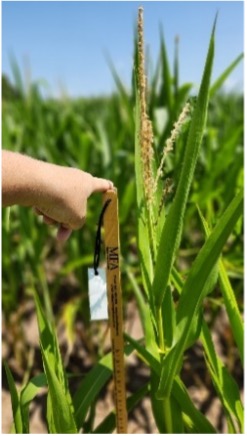Wisconsin leads the nation in corn silage production, harvesting over 19.8 million tons of silage (at 65% moisture) on approximately 880,000 acres in 2022. Corn silage is unique compared to multi-cut forage systems, such as alfalfa, as there is a single opportunity to properly harvest and store quality forage each year. With such high stakes riding on harvest management decisions, farmers and consultants must diligently monitor crop maturity and moisture to optimize harvest timing to balance silage yield, ensiling conditions, and forage quality.
Impacts from the 2023 growing season
The 2023 growing season has been highly variable across the state. Delays at planting (particularly in the northern half of the state) were the result of the cold, wet conditions that prevented farmers from getting into the fields early. Extremely dry conditions followed resulting in multiple emergence events and uneven stands throughout many corn fields across the state. Western and southern portions of Wisconsin have endured moderate, severe, or extreme drought (https://droughtmonitor.unl.edu/). While other portions of the state received timely, but very inconsistent precipitation. These less-than-ideal growing conditions have resulted in significant variability in crop growth, maturity and dry-down.
Monitor corn silage for proper harvest timing
Due to the significant crop variability, it is imperative farmers and consultants regularly monitor corn silage acres to properly time harvest activities. Harvesting silage at the proper moisture content for the intended storage structure allows for the proper packing and ensiling, reduces forage spoilage, and minimizes the production of leachates. Whole field moisture content, as well as areas of differential maturity and dry down within a field, should be documented in order to develop a harvest strategy to ensure the average moisture content of the packed forage is consistent and within an acceptable range.
Crop moisture levels can be determined by bringing whole plant samples to silage dry-down events commonly hosted by area Forage Councils and agricultural cooperatives. In addition, chopped samples can be submitted to local testing laboratories. Moisture test results from area corn silage dry-down events co-hosted by UW-Madison, Division of Extension and local Midwest Forage Association (MFA) affiliate Forage Councils are available at https://cropsandsoils.extension.wisc.edu/corn-silage-dry-down/. Additional information on Maximizing Corn Silage Yield and Quality is available at: https://cropsandsoils.extension.wisc.edu/articles/maximizing-corn-silage-yield-and-quality/.
Monitoring crop moisture status and developing a harvest strategy, particularly for stressed and uneven fields, will help maximize forage quality and yield. The Midwest Forage Association (MFA) and Outagamie Forage Council will host a Summer Twilight Meeting on Wednesday, August 16th at 6:45 p.m. The event is open and free to the public, however, we would ask that you RSVP for the meal count by Monday, August 14th at https://outagamie.extension.wisc.edu/forage-council-hosts-twilight-meeting/. You can also call (920)-832-4763 to RSVP or email Ina Montgomery at ina.montgomery@outagamie.org.







